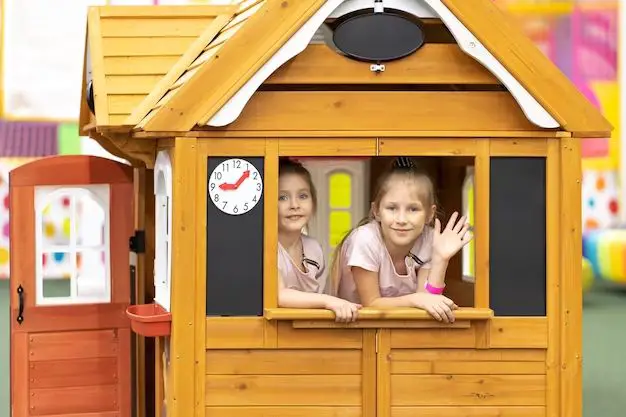Determining the appropriate age for a child to have a playhouse is an important consideration for parents. Playhouses allow children to explore imaginary worlds, develop social skills through roleplay, and gain independence in a safe environment. However, factors like size, features, and location must be evaluated to choose a playhouse suitable and safe for a child’s age and development stage.
Page Contents
Infants and Toddlers
Infants and toddlers from around 6 months to 3 years old do not require an actual playhouse structure. However, simple play tents, tunnels, and cubes allow babies and toddlers to explore in a safe enclosed space. Look for structures made of soft, lightweight materials like cotton, canvas, or mesh that can be easily wiped clean. Supervision is still required with this young age group.
Baby Play Tents
Play tents for infants provide an enclosed space for baby to play inside while being watched by an adult. Look for tents with mesh windows for ventilation and wide openings for easy adult access. Tents with detachable tunnels allow crawling babies to move safely from the tent through the tunnel. Activity arches and hanging toys add sensory stimulation and interactivity. Sturdy frames ensure the tent does not collapse. Set up tents on soft surfaces like carpets.
Play Cubes and Ball Pits
Lightweight pop-up play cubes create an enclosed play space for sitting or crawling babies. Some play cubes have activity panels with lights, sounds, and toys to entertain baby. For more active toddlers, play cubes can be converted to ball pits by adding plastic balls. Always provide close adult supervision and limit ball pit play to 10-15 minutes at a time.
Ages 3 to 5 Years
Preschool aged children from 3-5 benefit from a playhouse that encourages imaginary play and social interactions. Look for sturdy plastic units no more than 4 feet tall for this age group. Include child-sized tables, chairs, toy kitchenettes, and other accessories to inspire roleplay. Place near the home for easy adult monitoring. Models with locking doors or gates prevent wandering.
Plastic Playhouses
Sturdy plastic playhouses are ideal for preschoolers ages 3-5. Look for models no more than 4 feet tall with wide openings and high-quality plastic construction that will not easily crack or warp. Playhouses should have rounded corners for safety. Slanted plastic roofs prevent rainwater accumulation. Windows and Dutch doors add character and visibility. Locking doors with gate latches keep little ones safely contained while playing.
Features to Include
To encourage imaginative play, choose plastic playhouses with the following kid-sized accessories:
- Table and chairs
- Play kitchenette
- Lighting and battery powered fans
- Plastic shelves, flower boxes, and shuttered windows
- Chalkboard panels
- Play phone, cash register, or other interactive toys
Safety Tips
To keep preschoolers safe while using playhouses:
- Place on level ground in view of adults
- Check for hazards like sharp edges
- Secure to ground to prevent tipping
- Keep away from pools and other drop-offs
- Don’t overload electrical features
Ages 5 to 8 Years
Children ages 5-8 still benefit from imaginative play and will enjoy a playhouse scaled to their size. Look for houses up to 6 feet tall with kid-friendly themes, windows, doors, and accessories. Sturdy wooden or heavy-duty resin constructions will withstand more active play.
Wooden Playhouses
Wooden playhouses appeal to kids’ imaginations and withstand heavy use. Cedar and redwood resist weathering and rot naturally. Use exterior grade plywood for flooring. Check for splinters before use. Include plexiglass windows that won’t shatter if broken. Install a tongue-and-groove roof with shingles. Paint and finishes protect the wood.
Resin Playhouses
Modern resin playhouses mimic wood but are more durable and splinter-free. Look for commercial-grade resin made from recycled materials. Modular plastic panels assemble easily into whimsical shapes like castles, ships, and cottages. Resin resists fading and cracking better than plastic. Install roofs and accessories to customize the playhouse.
Safety Features
Look for the following safety conscious design elements when choosing wooden and resin playhouses for ages 5-8:
- No higher than 6 feet tall
- Wide openings, high windows, and good visibility
- Rounded corners and edges
- Ventilated for air circulation
- Doors with locking latches
- Anchored into ground
Ages 8 to 12 Years
Older children ages 8-12 desire independence and imaginative play. Multi-level playhouses up to 10 feet tall with separated rooms and built-in activities satisfy their evolving developmental needs. Durability and customization are also important.
Multi-Level Wooden Playhouses
Large wooden playhouses with lookout towers, covered porches, balconies, and separated rooms appeal to older kids’ sense of adventure and imagination. Use sturdy cedar that resists rotting and cracking. Multi-level playhouses may include:.
- Stairs, ladders, and climbing rocks
- Slides, swings, and outdoor toys
- Several divided rooms for activities
- Ramadas, canopies, and balcony areas
Install securely into the ground on a level area. Weather protection like exterior grade stain and shingled roofs help the playhouse last for years.
Customizing Playhouses
Older kids will enjoy personalizing their playhouse. Options include:
- Help designing and building the structure
- Selecting paint colors and finishes
- Adding decorative elements like curtains and lofts
- Choosing activity accessories: whiteboards, desks, hammocks
Allowing kids to customize their playhouse boosts emotional investment and imagination.
Safety Considerations
Take these precautions with multi-level playhouses:
- Supervise use until children display maturity
- Limit height to 10 feet maximum
- Use sturdy bracing and anchor into ground
- Include slip-resistant decking and handrails
- Keep away from water features and cliffs
Conclusion
The appropriate age for a child’s first playhouse depends on developmental stage, safety, and features needed for enriching imaginative play. Start babies and toddlers with simple play tents and cubes. Preschoolers thrive in plastic playhouses scaled to their size. School aged children enjoy customized, multi-level wooden playhouses. Select durable, creative playhouses suited to the child’s evolving maturity and independence.
